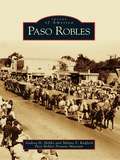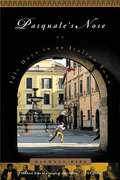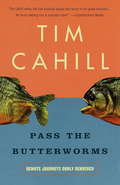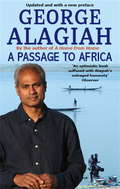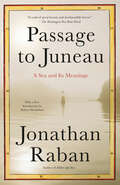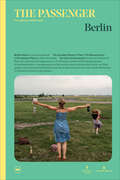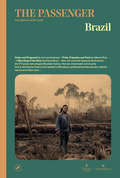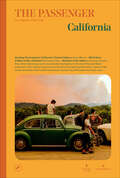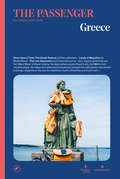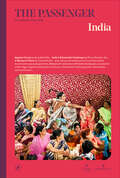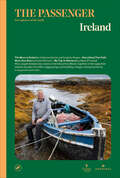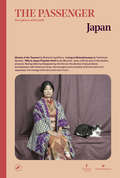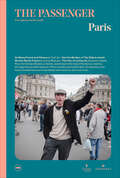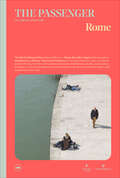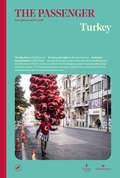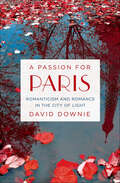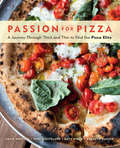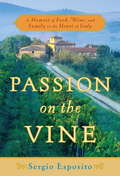- Table View
- List View
Paso Robles
by Paso Robles Pioneer Museum Andrea H. Hobbs Milene F. RadfordHalfway between Los Angeles and San Francisco, the historic town of Paso Robles became known for its abundance of hot mineral springs that brought relief from pain--first for the Salinan Indians, then for the Franciscan friars. As word of the springs' healing powers spread, hotels and bathhouses were built to accommodate the tourists who came seeking cures. The little community developed steadily after 1886, when the railroad arrived and town lots were auctioned. Area homesteaders raised cattle, grew grain, and planted fruit, walnut, and almond orchards--all without irrigation. Once known as the almond capital of the world, Paso Robles' agriculture has gradually changed from dry-land farms to irrigated vineyards. Tourists are attracted to Paso Robles for its mild climate, beautiful scenery, and mineral baths, which are being revived. The area's rich heritage is portrayed through more than 200 images from public and private historical collections.
Pasquale's Nose: Idle Days in an Italian Town
by Michael RipsA refreshing antidote to the saccharine charms of Peter Mayle's A Year in Provence and Frances Mayes' Under the Tuscan Sun, this is the quirky and hilarious memoir of a criminal lawyer who gives up his New York practise to spend a year in the Etruscan town of Sutri, near Rome, where he moves -reluctantly - with his artist wife and baby. Himself something of an eccentric from a bizarre Nebraskan family, he has spent his adult life living in hotels; and in Sutri, he heads straight for the cafe in the main square. From there he observes the baroque events of small-town life, conjures up a cast of Italian eccentrics (including Pasquale and his hypersensitive organ of smell), and relishes the weirdness and the wonder of Sutri 's history, folklore, architecture and above all its food -particularly the notorious 'fagioli regina' (beans in a tomato and pig skin sauce) and the annual Bean Festival. Part of the delight of reading this memoir is that it not only evokes the sights and smells of an ancient and little-known town in Southern Italy, and brings its people to extraordinary life, but it also reveals the irresistible foibles and philosophy of a talented and unusual mind. Funny, philosophical and surprisingly moving, this is the story of how a rootless American finds home in the most unexpected places and how Pasquale and his compatriots put life into perspective in the strangest way.
Pass the Butterworms
by Tim CahillIn Pass the Butterworms Cahill takes us to the steppes of Mongolia, where he spends weeks on horseback alongside the descendants of Genghis Khan and masters the "Mongolian death trot"; to the North Pole, where he goes for a pleasure dip in 36-degree water; to Irian Jaya New Guinea, where he spends a companionable evening with members of one of the last head-hunting tribes. Whether observing family values among the Stone Age Dani people, or sampling delicacies like sautéed sago beetle and premasticated manioc beer, Cahill is a fount of arcane information and a master of self-deprecating humor.
Passage to Afghanistan
by Peter BussianIn 2001, the Taliban approved Peter Bussian's request to photograph Afghanistan, asking him to "show the world the true Afghanistan," and for the past fifteen years, he's followed through on his promise to do so. In total, Bussian has spent nearly four years on the ground in Afghanistan, traveling there as both a photojournalist and with aid organizations such as the United Nations. In this entrancing volume, Bussian presents 150 photographs of what he calls "the land that time forgot." His captivating images feature everything from jaw-dropping landscapes-jagged mountains, desolate deserts, broad planes, and lush valleys-to its passionate people-Kabul street vendors and donkey cart drivers, devout Muslims, and displaced refugees.A fascinating introduction gives perspective on the special allure of the land-a place whose mystery was described by great poets, such as Rumi and Kipling, and that today is grounded in the fierce independence of its people, a physical and mental toughness that survives, even thrives, despite forty years of uninterrupted wars, and great famines.Side-by-side with the photographs are enlightening captions to give context to the compelling, memorable images. As a compilation, this is one of the most significant visual volumes of our time. While the world is at war with terrorism, Afghanistan, for many, represents the start of it all: the home of the terrorists behind 9/11 and the physical center of where America began its war on terrorism. To understand what we are up against and what follows Western intervention, here, at last, is a visual gateway: a portal to a significant, but little-understand land.
A Passage To Africa
by George AlagiahAs a five-year-old, George Alagiah emigrated with his family to Ghana - the first African country to attain independence from the British Empire. A PASSAGE TO AFRICA is Alagiah's shattering catalogue of atrocities crafted into a portrait of Africa that is infused with hope, insight and outrage. In vivid and evocative prose and with a fine eye for detail Alagiah's viewpoint is spiked with the freshness of the young George on his arrival in Ghana, the wonder with which he recounts his first impressions of Africa and the affection with which he dresses his stories of his early family life. A sense of possibility lingers, even though the book is full of uncomfortable truths. It is a book neatly balanced on his integrity and sense of obligation in his role as a writer and reporter. The shock of recognition is always there, but it is the personal element that gives A PASSAGE TO AFRICA its originality. Africa becomes not only a group of nations or a vast continent, but an epic of individual pride and suffering.
A Passage To Africa
by George AlagiahAs a five-year-old, George Alagiah emigrated with his family to Ghana - the first African country to attain independence from the British Empire. A PASSAGE TO AFRICA is Alagiah's shattering catalogue of atrocities crafted into a portrait of Africa that is infused with hope, insight and outrage. In vivid and evocative prose and with a fine eye for detail Alagiah's viewpoint is spiked with the freshness of the young George on his arrival in Ghana, the wonder with which he recounts his first impressions of Africa and the affection with which he dresses his stories of his early family life. A sense of possibility lingers, even though the book is full of uncomfortable truths. It is a book neatly balanced on his integrity and sense of obligation in his role as a writer and reporter. The shock of recognition is always there, but it is the personal element that gives A PASSAGE TO AFRICA its originality. Africa becomes not only a group of nations or a vast continent, but an epic of individual pride and suffering.
Passage to Burma
by Scott StulbergGet lost in the timeless beauty of a country in transition. It is a charming and satisfying thing that there are still places in this world where magic seems to pervade the sights, smells, and sounds of a place more than the trappings of the so-called modern world. For more than ten years Scott Stulberg has made multiple pilgrimages to Burma (sometimes called Myanmar) to capture this sense of magic with his cameras. The result of those pilgrimages is captured here in a collection of images that display the heart and soul of this magnificent country. This is a place of dreams. Bagan, where two thousand pagodas carved from the native rock occupy an area one-sixth the size of Washington, DC. Mandalay, an exercise in calm and chaos that seduces the eye in every direction. Inle Lake, where images pop up around every corner: fishermen in their long boats, their legs wrapped strangely around the paddles; small villages clustered along the water like clumps of mussels clinging to a rocky shoreline. Mrauk, a place so remote that tourists are a curious rarity. And Yangon (once Rangoon), a tropical coastal city that still bears the remnants of colonial rule along its shady avenues. And around every corner of this country of contrasts are Burma’s Buddhist monks in their distinct saffron robes. Their warmth and openness have come to symbolize this amazing country. This second edition of Passage to Burma includes new photographs from Stulberg’s latest travels abroad to this remarkable place. “This is Burma,” wrote Ruyard Kipling. “It is quite unlike any place you know about. ”
Passage to Burma
by Scott StulbergIt is a charming and satisfying thing that there are still places in this world where magic seems to pervade the sights, smells, and sounds of a place more than the trappings of the so-called modern world. For more than ten years Scott Stulberg has made multiple pilgrimages to Burma (sometimes called Myanmar) to capture this sense of magic with his cameras. The result of those pilgrimages is captured here in a collection of images that display the heart and soul of this magnificent country.Burma is a place of dreams. Bagan, where two thousand pagodas carved from the native rock occupy an area one-sixth the size of Washington, DC. Mandalay, an exercise in calm and chaos that seduces the eye in every direction. Inle Lake, where small villages cluster along the water like mussels clinging to the rocky shore. Mrauk, a place so remote that tourists are a curious rarity. And Yangon, (once Rangoon), a tropical coastal city that still bears the trappings of colonial rule along its shady avenues. And around every corner of this country of contrasts are Burma's Buddhist monks in their distinct saffron robes. Their warmth and openness have come to symbolize this amazing country.Passage to Burma is Stulberg's photographic tribute to this remarkable place. It is a country in transition, yet with a timeless quality to it that is captured beautifully in the images in this book. "This is Burma," wrote Ruyard Kipling, "it is quite unlike any place you know about."
Passage to Israel
by Karen Lehrman Bloch Chloé Simone ValdaryBursting with lush, vibrant photographs, Passage to Israel is a timeless tribute to one of the world's most soulful, resolute, and newsworthy countries. Divided into sections such as Soul, Spirit, Awe, Quiet, and Unity, the stunning images featured inside capture Israel's glorious landscapes, its city life, its culture, and its people. From an enchanting sunset over the Dead Sea to the lively city life of Tel Aviv, from colorful marketeers to families in prayer at the Western Wall, this incredible volume moves full-steam ahead past the typical postcard images of the country to showcase the character of its people and the sanctity of the land they're so resolute in preserving. Contributors to Passage to Israel include twenty-five iconic and groundbreaking photographers, acclaimed artists such as Markus Gebauer and Amit Geron, and more than 150 of their images are featured inside. As a precursor to the images is an enlightening introduction by the author, a renowned cultural critic and curator, that provides a fascinating frame for the photographs to come.Throughout, explanatory captions are featured side-by-side with the images.For a country roughly the size of New Jersey and only formally declared a state in 1948, not too long ago, Israel is easily the world's most controversial land, one that's withstood regular suicide bombing, violent attacks, and political pressure. Yet its people refuse to be silenced; they will protect their borders and they will continue to persevere.For those who've been to Israel and those who've yet to make the trip there, here, at last, is a truly immersive experience, an inspiring visual connection to a remarkable, but faraway land
Passage to Juneau: A Sea and Its Meanings (Vintage Departures)
by Jonathan RabanThe bestselling, award-winning author of Bad Land takes us along the Inside Passage, 1,000 miles of often treacherous water, which he navigates solo in a 35-foot sailboat, offering captivating discourses on art, philosophy, and navigation and an unsparing narrative of personal loss."A work of great beauty and inexhaustible fervor." —The Washington Post Book WorldWith the same rigorous observation (natural and social), invigorating stylishness, and encyclopedic learning that he brought to his National Book Award-winning Bad Land, Jonathan Raban conducts readers along the Inside Passage from Seattle to Juneau. But Passage to Juneau also traverses a gulf of centuries and cultures: the immeasurable divide between the Northwest's Indians and its first European explorers—between its embattled fishermen and loggers and its pampered new class.
Passage to Wonderland: Rephotographing Joseph Stimson's Views of the Cody Road to Yellowstone National Park, 1903 and 2008
by Michael A. AmundsonIn 1903 the Cody Road opened, leading travelers from Cody, Wyoming, to Yellowstone National Park. Cheyenne photographer J. E. Stimson traveled the route during its first week in existence, documenting the road for the state of Wyoming's contribution to the 1904 World's Fair. His images of now-famous landmarks like Cedar Mountain, the Shoshone River, the Holy City, Chimney Rock, Sylvan Pass, and Sylvan Lake are some of the earliest existing photographs of the route. In 2008, 105 years later, Michael Amundson traveled the same road, carefully duplicating Stimson's iconic original photographs. In Passage to Wonderland, these images are paired side by side and accompanied by a detailed explanation of the land and history depicted. Amundson examines the physical changes along "the most scenic fifty miles in America" and explores the cultural and natural history behind them. This careful analysis of the paired images make Passage to Wonderland more than a "then and now" photography book--it is a unique exploration of the interconnectedness between the Old West and the New West. It will be a wonderful companion for those touring the Cody Road as well as those armchair tourists who can follow the road on Google Earth using the provided GPS coordinates. The University Press of Colorado gratefully acknowledges the generous support of the Charles Redd Center for Western Studies at Brigham Young University toward the publication of this book.
Passage to Wonderland
by Michael A. AmundsonIn 1903 the Cody Road opened, leading travelers from Cody, Wyoming, to Yellowstone National Park. Cheyenne photographer J. E. Stimson traveled the route during its first week in existence, documenting the road for the state of Wyoming's contribution to the 1904 World's Fair. His images of now-famous landmarks like Cedar Mountain, the Shoshone River, the Holy City, Chimney Rock, Sylvan Pass, and Sylvan Lake are some of the earliest existing photgraphs of the route. In 2008, 105 years later, Michael Amundson traveled the same road, carefully duplicating Stimson's iconic original photographs. In Passage to Wonderland, these images are paired side by side and accompanied by a detailed explanation of the land and history depicted. Amundson examines the physical changes along "the most scenic fifty miles in America" and explores the cultural and natural history behind them. This careful analysis of the paired images make Passage to Wonderland more than a "then and now" photography book--it is a unique exploration of the interconnectedness between the Old West and the New West. It will be a wonderful companion for those touring the Cody Road as well as those armchair tourists who can follow the road on Google Earth using the provided GPS coordinates.
The Passenger: Berlin (The Passenger)
by The PassengerThe best new writing, photography, art, and reportage from and about Berlin—in the series that’s “like a literary vacation” (Publishers Weekly).In 1990s Berlin, the scars of a century of war were still visible everywhere: coal stoves, crumbling buildings, desolate minimarts, not a working buzzer or elevator. To visit the city then was a hallucinatory experience, a simultaneous journey into the past and into the future.The abandoned ruins, the hidden gems found at the flea market, the illegal basement raves are a thing of the past. The era of Berlin as a site of urban archeology is over. Almost all the damaged buildings have been repaired, squatters have been removed, the shops selling East German furniture have closed down. Without its wounds, the landscape of the city is perhaps less striking but more solid, stronger. Even the city’s inhabitants have lost some of their melancholia, their romantic and self-destructive streak: today you can even find people who come to Berlin to actually work, not just to “create” or idle their days away. Yet, Berlin remains a youthful city and retains its aura as “the capital of cool.” Its only sacrosanct principles are an uncompromising multiculturalism and the belief that its future is yet to be written. This volume of the series includes:The Greatest Show in Town: The Resurrection of Potsdamer Platz by Peter Schneider · Berlin Suite by Cees Nooteboom · Tempelhof: A Field of Dreams by Vincenzo Latronico · Plus: the controversial reconstruction of a Prussian castle, Berlin’s most transgressive sex club and its disappearing traditional pubs, a green urban oasis, suburban neo-Nazis, North Vietnamese in the East, South Vietnamese in the West, techno everywhere and much more . . . “These books are so rich and engrossing that it is rewarding to read them even when one is stuck at home.” —The Times Literary Supplement
The Passenger: Brazil (The Passenger)
by The PassengerAn in-depth look at Brazilian culture in the series that collects the best new writing, photography, art, and reportage from around the world.In the second half of the twentieth century Brazil made extraordinary contributions to music, sport, architecture. From bossa nova to acrobatic soccer to the daring architecture of Oscar Niemeyer and Lúcio Costa, the country seemed to embody a new, original vision of modernity, at once fluid, agile, and complex.Seen from abroad, the victory of the far right in the 2018 elections was a rude awakening that suddenly turned the Brazilian dream into a nightmare. For locals, however, illusions had started fading long ago, amid paralyzing corruption, environmental degradation, racial discrimination, and escalating violence. Luckily Brazilians have not lost their desire to fight, minorities are still determined to assert their rights, and, now that the glorious past is dead and buried, a desire to rebuild for the future is emerging. Today the challenge of telling the story of this extraordinary country consists in finding its enduring vitality amid the apparent melancholy.“The Passenger readers will find none of the typical travel guide sections on where to eat or what sights to see. Consider the books, rather, more like a literary vacation.” —Publishers Weekly“Much more than a travel guide, The Passenger is indispensable for any reader who is curious about the world.” —Il VenerdìIn this volume: Order and Progress? by Jon Lee Anderson Funk, Pride and Prejudice by Alberto Riva On the River, I Was King by Eliane Brum Also: the road that dissects the Amazon; the TV tycoon who shaped Brazilian history; the neo-Pentecostal community that is winning the hearts (and wallets) of Brazilians; politicized samba dancers, idealist gangsters, and much more . . .
The Passenger: California (The Passenger)
by The PassengerThe best new writing, photography, art, and reportage from and about California—in the “rich and engrossing” series for travelers and armchair travelers (Times Literary Supplement).From the Gold Rush to Hollywood’s golden age to the rise of Silicon Valley, California has long stood as the brightest symbol of the American dream. In recent years, however, the country’s mainstream media has been declaring with increasing frequency—and thinly veiled schadenfreude—the “end of California as we know it.”The pessimists point to rising inequality, racial tensions, and the impact of climate change as evidence that the Californian dream has been shattered. Between extreme heat, months-long droughts, devastating wildfires, and rising sea levels, looking at California is like watching the trailer for what awaits the world if we don’t act to reduce global warming. Faced with these pressures, more and more Californians are leaving the state, leading to an unprecedented decline in population that could change the cultural and political balance of power in the country at large.That said, demographic decline and climate disasters don’t tell the whole story of one of the most dynamic and diverse states in the Union—one that continues to drive technological and political innovation and define the evolution of work, food, entertainment, and social relations. This volume offers a fascinating picture of California in all its complexity and contradictions—an attempt to understand the laboratory where much of the world’s future continues to be written—with pieces including:Growing Uncertainty in the Central Valley by Anna Wiener • How Does It Feel to Be a Solution? by Vanessa Hua • The Burning of Paradise by Mark Arax • Plus: direct democracy and unsustainable development, the rise of the “land back” movement, the cultural renaissance of Los Angeles in defiance of rampant gentrification, and much more . . . “The Passenger readers will find none of the typical travel guide sections on where to eat or what sights to see. Consider the books, rather, more like a literary vacation.” —Publishers Weekly
The Passenger: Greece (The Passenger)
by The PassengerA vivid portrait of life in Greece, in the series that collects the best new writing, photography, art and reportage from around the world.Many have impressions and opinions about Greece based on superficial headlines or pop culture stereotypes. This volume of The Passenger offers instead a wide-ranging, thoughtful, and lively picture of the country in all its nuance and diversity—its people, its problems, its art, its athletes, and much, much more.“The Passenger readers will find none of the typical travel guide sections on where to eat or what sights to see. Consider the books, rather, more like a literary vacation.” —Publishers WeeklyIn this volume:Once Upon A Time: The Greek Taverna by Petros Markaris Land of Migration by Matteo Nucci The Lost Generation by Christos Ikonomou Plus: Yorgos Lanthimos and the “Weird Wave” of Greek cinema, the island where people forget to die, the NBA’s most valuable player, the mayor who balanced the books but enraged the nationalists, abandoned buildings, oligarchs on the rise, the rebellious rhythm of rebetiko and much more . . .
The Passenger: India (The Passenger)
by The PassengerA journey into today’s India through essays, photography, and more, shortlisted for a 2022 Edward Stanford Travel Writing Award.Since its earliest interactions with the West, India has been the object of a gross misinterpretation, a vague association with ideas of peace, spiritualism, the magic of the fakirs. Constantly reframed and mythologized by Westerners fleeing their supposedly rationalist societies, India continues to fascinate with its millennia-old history, shrines on every street corner, ancient beliefs and rituals, and unique linguistic and cultural diversity.Today this picture is mixed with that of a society changing at a frenetic pace and at the forefront of the digital revolution—a “shining India” of dynamic, fast-expanding megalopolises. Yet these success stories coexist with the daily plight of the large section of its population without access to drinking water or a toilet, with a rural economy (still employing the majority of its over 1.3 billion inhabitants) that depends on monsoons for irrigation and is threatened by climate change. The greatest democratic experiment ever attempted, India remains plagued by one of the vilest forms of class and racial discrimination, the caste system, exacerbated by the Hindu nationalist regime.All things considered, though, it’s hard to find a more dynamic and optimistic country or, as Arundhati Roy puts it, “a more irredeemably chaotic people.” This volume aims to depict India’s chaos and its contradictions, its terror and its joy, from the struggle of the Kashmiris to that of non-believers (hated by all religious sects), from the dances of the hijra in Koovagam to the success of the wrestler Vinesh Phogat, a symbol of the women who seek to free themselves from the oppressive patriarchal mores. Despite the obstacles and steps back, India continues its journey on the long path toward freedom and toward ending poverty for some of the world’s most destitute. Included are writings on:Caste: Yesterday, Today, and Tomorrow by Arundhati Roy · The Invention of Hindu Nationalism by Prem Shankar Jha · No Country for Women by Tishani Doshi · Plus: the grand ambitions of the world’s most underrated space program, Bollywood’s obsession with Swiss landscapes, an ode to Bengali food, eagerly awaiting the monsoon, the wrestler tackling stereotypes and much more . . . “These books are so rich and engrossing that it is rewarding to read them even when one is stuck at home.” —The Times Literary Supplement
The Passenger: Ireland (The Passenger)
by The PassengerThe best new writing, photography, art, and reportage from and about Ireland—in the series that’s “like a literary vacation” (Publishers Weekly).Ireland is a land full of charm and conflict, a country that in just a few decades has gone from being a poor, semi-theocratic society to a thriving economy free from the influence of the Catholic Church. With the 1998 peace agreements, the conflict between nationalists and unionists seemed, if not resolved, at least dormant. But Brexit—with the ambiguous position it leaves Northern Ireland in—caused old tensions to resurface, with ramifications in politics, society, culture, and sport.Meanwhile, south of the border, epochal transformation has seen a deeply patriarchal, conservative society give space to diversity, the only country in the world to enshrine gay marriage in law through a referendum. And there’s a whole other Ireland abroad, an Irish diaspora that looks to the old country with newfound pride but doesn’t forget the ugliness it fled from.Memory and identity intertwine with the transformations—from globalization to climate change—that are remodeling the Irish landscape, from the coastal communities under threat of disappearing along with the Irish language fishermen use to talk about the sea, inland the peat bogs, until recently important sources of energy and jobs, are being abandoned. Pieces in this collection include:The mass is ended by Catherine Dunne and Caelainn Hogan · The Way Back by Colum McCann · A Trip to Westeros by Mark O’Connell · Plus: life on the margins of two unions and right in the middle of Brexit, making war on each other for thirty years while playing on the same national rugby team, emigrating to the great enemy or transforming the country one referendum at a time, digging peat bogs and building cottages, talking of the sea in Gaelic, and much more . . . “These books are so rich and engrossing that it is rewarding to read them even when one is stuck at home.” —The Times Literary Supplement
The Passenger: Japan (The Passenger)
by The PassengerExplore Japanese society in the lively series that collects the best new writing, photography, art, and reportage from around the world.Visitors from the West look with amazement, and sometimes concern, at Japan’s social structures and unique, complex culture industry; the gigantic scale of its tech corporations and the resilience of its traditions; the extraordinary diversity of the subcultures that flourish in its “post-human” megacities. The country nonetheless remains an intricate and complicated jigsaw puzzle, an inexhaustible source of inspiration for stories, reflections, and reportage. Caught between an aging population and extreme post-modernity, Japan is an ideal observation point from which to understand our era and the one to come. The subjects in this volume form a portrait of the country that ranges from the Japanese veneration of the dead to the Tokyo music scene, from urban alienation to cinema, from sumo to toxic masculinity.“The Passenger readers will find none of the typical travel guide sections on where to eat or what sights to see. Consider the books, rather, more like a literary vacation.” —Publishers WeeklyIn this volume:Ghosts of the Tsumani by Richard Lloyd Parry Living in Shimokitazawa by Yoshimoto Banana Why Japan Has Avoided Populism by Ian Buruma Plus: a Shinto sect in the shadow of power, fleeing debts by disappearing into thin air, the decline of sexual desire, the obsession with American blues, the strongest sumo wrestler of all time (who isn’t Japanese), the revenge of the Ainu and much more . . .
The Passenger: Paris (The Passenger)
by The PassengerThe best new writing, photography, art, and reportage from and about Paris—in the “rich and engrossing” series for literary travelers (Times Literary Supplement).Paris’s postcard image has suffered multiple blows in recent years: the November 2015 terrorist attacks, the demonstrations of the yellow vests, the riots in the suburbs, Notre-Dame in flames, record heatwaves and the coronavirus. Meanwhile, soaring living costs are forcing many Parisians to leave the city.Yet these are not just a series of unfortunate events. They are phenomena—from increasing population density to climate change, from immigration to the repercussions of globalization and geopolitics—that all metropolises in the world must face. And in Paris, today, the mood is not one of defeat but of renewal: from the city’s ongoing environmental and urbanistic transformation to the fight by a new generation of chefs against the traditionalism of starred restaurants; from the children of immigrants who take to the streets for the right to feel French to the women determined to break the sexism and stereotypes that dominate the fashion industry. Is there anyone who seriously thinks they can teach Parisians how to make a revolution? This volume includes:Out of the Shadows by Tash Aw · Against the Stars by Tommaso Melilli · Afraid of Being Free by Samar Yazbek · Plus: the Champs-Elysées between luxury and riots, the French Republic between anti-Semitism and Islamophobia, the most elegant Congolese dandies of all time, one Parisian woman you will not encounter, the city’s legendary football team that is not the PSG, and much more . . . “The Passenger readers will find none of the typical travel guide sections on where to eat or what sights to see. Consider the books, rather, more like a literary vacation.” —Publishers Weekly
The Passenger: Rome (The Passenger)
by The PassengerThe best new writing, photography, art, and reportage from and about Rome—in the series that’s “like a literary vacation” (Publishers Weekly).If you believe recent chatter about Rome—in the media and by its residents—the city is on the verge of collapse. Each year, it slips further down the ranking of the world’s most livable cities. To the problems faced by all large capitals—hit-and-run tourism, traffic, the divide between elegant, Airbnb-dominated city centers and run-down suburbs—in recent years Rome seems to have added a list of calamities of its own: a string of failing administrations, widespread corruption, the resurgence of fascist movements, rampant crime. A seemingly hopeless situation, perfectly symbolized by the fact that Rome currently leads the world in the number of self-combusting public buses.One might expect mass migration in the face of problems like these—yet the vast majority of Romans don’t think for a second of “betraying” their hometown, and the many newcomers who’ve populated it in recent decades resemble the natives in the profound love that binds them to the city.The largest metropolis in Europe is a place of contradictions and opposites. We think of it as ancient, but it is profoundly modern—it was founded almost three millennia ago, but 92 per cent of its buildings have been built after 1945. To understand Rome and fix its problems, we should start considering it a normal city, not unlike Chicago or Manchester . . . just incomparably more beautiful. This volume is filled with portraits of Rome and thoughts not just on its famous past but its present and future, including:Rome doesn’t judge you by Nicola Lagioia · The soul of the city by Matteo Nucci · 39 memos for a book about Rome by Francesco Piccolo · Plus: a guide to the sounds of Rome by Letizia Muratori; the feigned unrest and real malaise of the suburbs; the influence of the Vatican; the excessive power of real estate speculators and the rule of gangs; disillusioned trappers; football fans of every age, and much more . . . “A pleasure to read.” —La Repubblica
The Passenger: Turkey (The Passenger)
by The PassengerTurkish culture and history is explored in the wide-ranging series that is “like a literary vacation” (Publishers Weekly).The birth of the “New Turkey,” as the country’s President Recep Tayyip Erdogan has called his own creation, is an exemplary story of the rise of “illiberal democracies” through the erosion of civil liberties, press freedom, and the independence of the judicial system. Turkey was a complex country long before the rise of its new sultan: Born out of the ashes of a vast multi-ethnic and multi-religious empire, Turkey has grappled through its relatively short history with the definition of its own identity. Poised between competing ideologies, secularism and piousness, a militaristic nationalism and exceptional openness to foreigners, Turkey defies easy labels and categories.Through the voices of some of its best writers and journalists—many of them in self-imposed exile—The Passenger: Turkey tries to make sense of this fascinating, maddening country, analyzing how it got to where it is now, and finding the bright spots of hope that allow its always resourceful, often frustrated population to continue living, and thriving.In this volume:The Big Dig by Elif Batuman A Story of Dust and Light by Burhan Sönmez An Author Recommends by Elif Shafak Plus: the thirty-year coup and the dam that is washing away 12,000 years of history, and more.
A Passion for Paris: Romanticism and Romance in the City of Light
by David Downie"A top-notch walking tour of Paris. . . . The author's encyclopedic knowledge of the city and its artists grants him a mystical gift of access: doors left ajar and carriage gates left open foster his search for the city's magical story. Anyone who loves Paris will adore this joyful book. Readers visiting the city are advised to take it with them to discover countless new experiences." —Kirkus Reviews (starred)A unique combination of memoir, history, and travelogue, this is author David Downie's irreverent quest to uncover why Paris is the world's most romantic city—and has been for over 150 years.Abounding in secluded, atmospheric parks, artists' studios, cafes, restaurants and streets little changed since the 1800s, Paris exudes romance. The art and architecture, the cityscape, riverbanks, and the unparalleled quality of daily life are part of the equation.But the city's allure derives equally from hidden sources: querulous inhabitants, a bizarre culture of heroic negativity, and a rich historical past supplying enigmas, pleasures and challenges. Rarely do visitors suspect the glamor and chic and the carefree atmosphere of the City of Light grew from and still feed off the dark fountainheads of riot, rebellion, mayhem and melancholy—and the subversive literature, art and music of the Romantic Age.Weaving together his own with the lives and loves of Victor Hugo, Georges Sand, Charles Baudelaire, Balzac, Nadar and other great Romantics Downie delights in the city's secular romantic pilgrimage sites asking , Why Paris, not Venice or Rome—the tap root of "romance"—or Berlin, Vienna and London—where the earliest Romantics built castles-in-the-air and sang odes to nightingales? Read A Passion for Paris: Romanticism and Romance in the City of Light and find out.
Passion for Pizza: A Journey Through Thick and Thin to Find the Pizza Elite
by Craig Whitson Tore Gjesteland Mats Widén Kenneth Hansen“The authors showcase their passion for pizza in this intimate, behind the scenes tale about great artisanal pizza makers in Italy and America.” —Jonathan Goldsmith, owner, Spacca NapoliPassion for Pizza celebrates the people, personalities, and stories behind one of the world’s favorite foods. Not only a cookbook and a history book, it is also a tribute to the people and places that makes this dish a global favorite. It is a beautifully illustrated volume by a team of award-winning authors, photographers, and designers who diligently followed the smell of great pizza to wherever it led them. Passion for Pizza begins in Italy, introducing readers to pizzaioli in places such as Naples, Rome, and Palermo. Next up is the pizza of New York, Chicago, and California, where it’s as essential as baseball and mom’s apple pie. The authors visit the people who produce the cheeses, tomatoes, flour, and other ingredients used in pizza making, showing the global reach of locally sourced foods. This exuberant tour guide digs deep into pizza culture with interviews of oven-makers, consultants, professors, acrobats, and journalists.With more than fifty easy-to-follow recipes for individual pizzas and crusts, over forty pizzeria profiles, and twenty profiles of the people behind the pizza, this book inspires home cooks and aficionados alike.“Passion for Pizza reaches deep into the heart and soul of pizza makers from around the world. One of the finest, most groundbreaking books ever written about pizza and its industry.” —Tony Gemignani, author of The Pizza Bible“Can there be too much pizza? Or books about it? No and no. New on the pizza front is the gorgeously photographed Passion for Pizza.” —The Sacramento Bee
Passion on the Vine: A Memoir of Food, Wine, and Family in the Heart of Italy
by Sergio Esposito Justine Van Der LeunAs a young child in Naples, Italy, Sergio Esposito sat at his kitchen table observing the daily ritual of his large, loud family bonding over fresh local dishes and simple country wines. While devouring the richbufalamozzarella, still sopping with milk and salt, and the platters of fresh prosciutto, sliced so thin he could see through it, he absorbed the profound relationship of food, wine, and family in Italian culture. Growing up in Albany, New York, after emigrating there with his family, he always sat next to his uncle Aldo and sipped from his wineglass during their customary hours-long extended family feasts. Thus, from a very early age, Esposito came to associate wine with the warmth of family, the tastes of his mother's cooking--and, above all, memories of his former life in Italy. When he was in his twenties, he headed for New York and undertook a career in wine, beginning a journey that would culminate in his founding of Italian Wine Merchants, now the leading Italian wine source in America. His career offered him the opportunity to make frequent trips back to Italy to find wine for his clients, to learn the traditions of Italian winemaking, and, in so doing, to rediscover the Italian way of life he'd left behind. Passion on the Vineis Esposito's intimate and evocative memoir of his colorful family life in Italy, his abrupt transition to life in America, and of his travels into the heart of Italy--its wine country--and the lives of those who inhabit it. The result is a remarkably engaging and entertaining wine/travel narrative replete with vivid portraits of seductive places--the world-famous cellars of Piedmont, the sweeping estates of Tuscany, the lush fields of Campania, the chilly hills of Friuli, the windy beaches of Le Marche; and of memorable people, diverse and vibrant wine artisans--from a disco-dancing vintner who bases his farming on the rhythm of the moon to an obsessive prince who destroys his vineyards before his death so that his grapes will never be used incorrectly. Esposito's luscious accounts of the wonderful food and wine that are so much a part of Italian life, and his poignant and often hilarious stories of his relationships with his family and Italian friends, makePassion on the Vinean utterly unique and enchanting work about Italy and its eternally seductive lifestyle.
